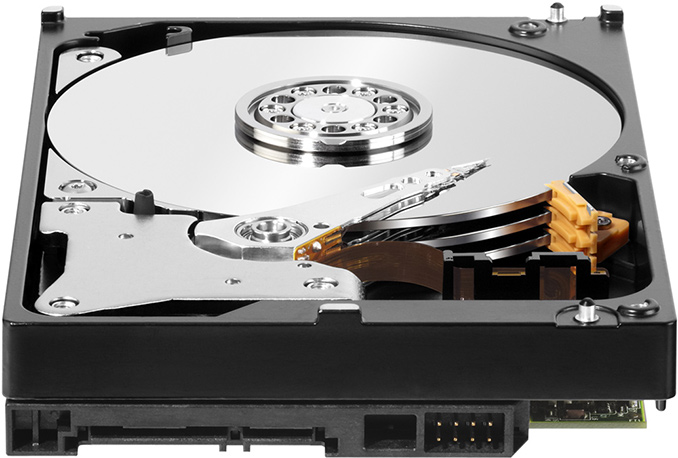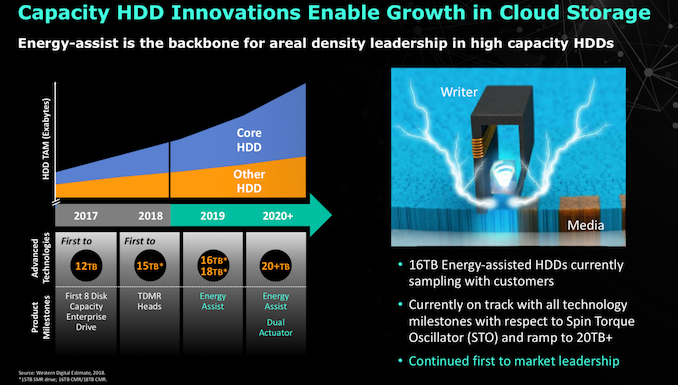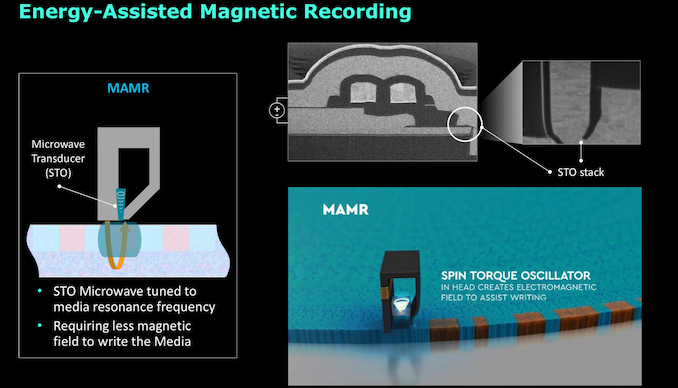16 TB MAMR Hard Drives in 2019: Western Digital
by Anton Shilov on January 4, 2019 3:10 PM EST- Posted in
- HDDs
- Storage
- Western Digital
- MAMR
- Helium HDD
- HAMR
- 16 TB
- 18 TB

Western Digital revealed recently that it has begun to sample its next-generation hard drives based on microwave assisted magnetic recording (MAMR) technology. The sampling is a prelude to mass production, which will see the first commercial HDDs based on the tech released this year. Meanwhile, the company is working on hard drives featuring two actuators that will arrive in 2020 or later. Overall, Western Digital remains confident in MAMR and expects to launch multiple generations of such drives. In the meantime, the firm is also admitting that it has continued to invest in development of alternative heat assisted magnetic recording (HAMR) technology.
“We are sampling our 16 TB [MAMR-based] product today,” said Michael Cordano, president and CEO of Western Digital, at the company’s meeting with financial analysts last month.
As expected back in 2017, the first MAMR-powered drives will feature 16 TB capacities and will use eight platters, which was confirmed by the executive during the event. Western Digital’s 16 TB HDD will be aimed at nearline applications and are intended for cloud datacenters as well as enterprises that require massive storage capacities. However Mr. Cordano did not clarify whether the MAMR-powered HDDs were only sampling with select customers (for example, Western Digital’s SMR-based HDDs are available only to select clients), or if they were being offered to a broader spectrum of clients.
Not Happy with 16 TB? How about 18 TB?
Western Digital has learnt a number of things while developing MAMR and plans to use the technology for many generations to come. For example, one of the company’s slides shows 18 TB HDDs also being planned for 2019. Meanwhile, 20+ TB drives with two actuators to increase per-TB IOPS performance are set to hit the market in 2020 (or beyond), with higher capacities following on later.
In general, Western Digital seems to be confident of its implementation of MAMR. The process will use a combination of heads made using its Damascene process, Spin Torque Oscillators (STO) to generate the 20-40 GHz microwaves that lower the coercivity of the media, and the new media itself. The tech has passed all the company’s milestones and it is ready to ramp it this year.
But while MAMR will be used for years to come, Western Digital continues to invest in development of its own HAMR technology. HAMR has been investigated by multiple firms, and rival Seagate will be using it for commercial products in 2019. This is a curious step on Western Digital's part, as in initially rejecting HAMR for MAMR, the company once claimed that HAMR was costly to implement and it posed reliability issues. By contrast, Seagate said that HAMR had better scaling when it comes to areal densities. Given this revelation, while Western Digital's path with MAMR seems to be set for the near future, it would seem that the company is going to hedge its bets in the longer term. In which case we may still see a HAMR Western Digital drive yet.
Related Reading:
- Western Digital Stuns Storage Industry with MAMR Breakthrough for Next-Gen HDDs
- Seagate’s Multi Actuator Technology to Address HDD IOPS Woes
- Seagate Starts to Test 16 TB HAMR Hard Drives
- Seagate Ships 35th Millionth SMR HDD, Confirms HAMR-Based Drives in Late 2018
- The Evolution of HDDs in the Near Future: Speaking with Seagate CTO, Mark Re
Source: Western Digital












25 Comments
View All Comments
DanNeely - Friday, January 4, 2019 - link
Maybe they're looking into it for a point some years down the line when both techs max out on their own and need to be combined into MHAMR drives to keep pushing capacities higher.darkswordsman17 - Friday, January 4, 2019 - link
Nah, I'll wait for the Microwave Convection Heat Assisted Magnetic Recording drives. Hopefully they come with proper warning stickers, "Can't Touch This"eastcoast_pete - Friday, January 4, 2019 - link
Since 20-40 GHz microwaves have mm wavelengths, WD can always market their MAMR drives as "5G drives" (: Take that, Seagate!Quite seriously, rollout of HAMR and MAMR drives is way overdue. Those 4K and upcoming 8K games and videos need space, and lot's of it.
darkswordsman17 - Friday, January 4, 2019 - link
Ugh, I shudder to think about trying to load 8K games off spinning HDD.FunBunny2 - Friday, January 4, 2019 - link
no problem. just have 128G on the motherboard. most folks can afford that. right?0ldman79 - Saturday, January 5, 2019 - link
Honestly, throw a 512GB SSD buffer on the drive. The game will only load slow the first time.I use caching programs at home, makes a huge difference and honestly it isn't that big of a deal to have the program load slow-ish once. 99% of the time I get SSD like performance out of my 2TB spinner that I've had a couple years now.
Brane2 - Friday, January 4, 2019 - link
No problem. But they have to solve the problem of aligning all heads on an arm individually. With each head being able to transfer 200ish Mb/s times 16 and you are on ~ 3GB/s. Per arm. Dual arm gives you twice that while halving average access time AND giving you redundant path to the same data.On top of that they just need some interchangeability - some way ordinary user can swap electronics on a drive for rescuing the data and they would make perfect long-term storage medium for mere mortals...
rygaroo - Saturday, January 5, 2019 - link
16 independently moving arms?!? Yikes, that sounds like a nightmare both in terms of design difficulty and reliability, but if would be pretty cool.Brane2 - Saturday, January 5, 2019 - link
No. 16 micropiezo mechanisms just for minute corrrections of each head on the same arm...FunBunny2 - Saturday, January 5, 2019 - link
I can't find a cite, alas, but when I was much, much younger high-performance mainframe disc drives had multiple, radial actuators. which is to say, more than 2.but, here's this (the wiki) about the IBM 3350:
"The "x2F", as in Model A2F, unit is a normal x2 unit, but its two HDAs also have a Fixed Head area over the first five cylinders, thereby reducing[c] seek time to zero for these five cylinders."